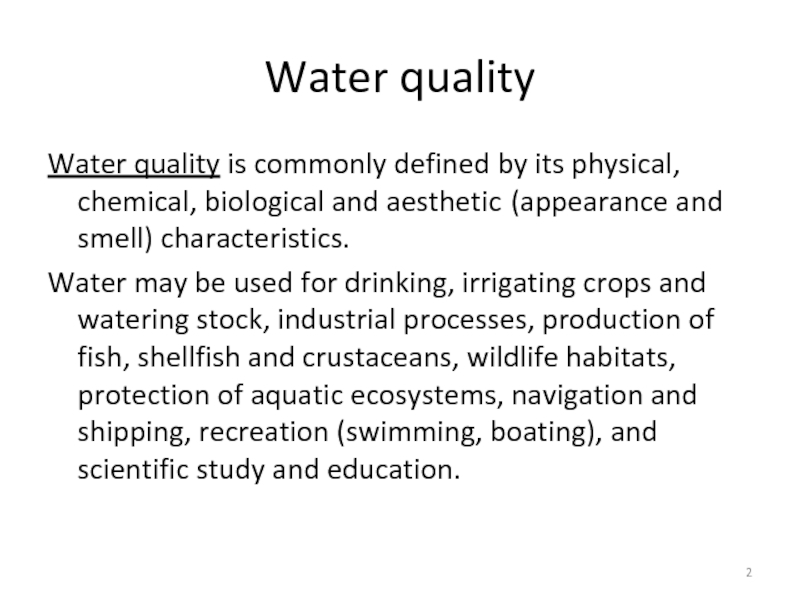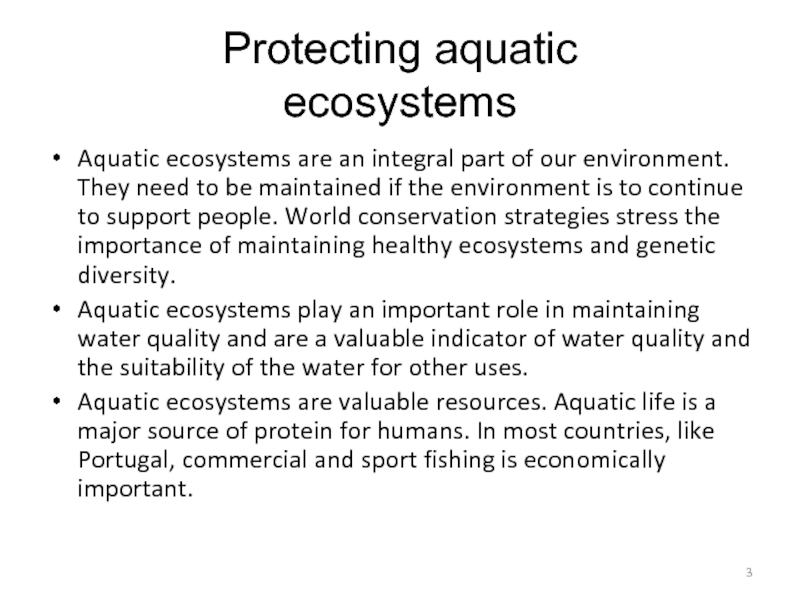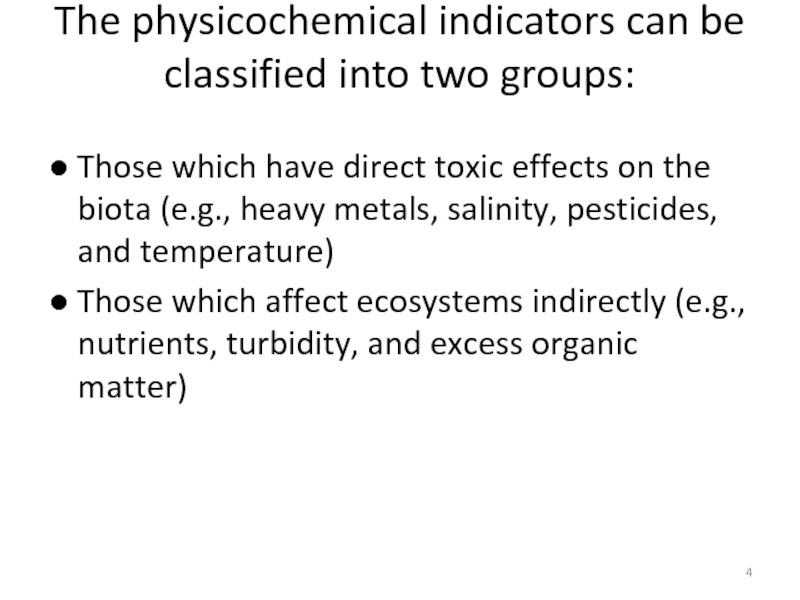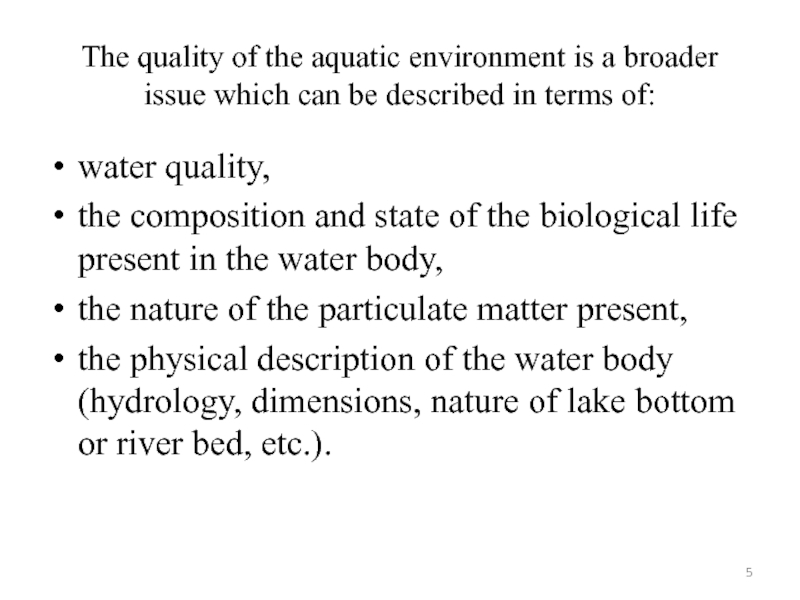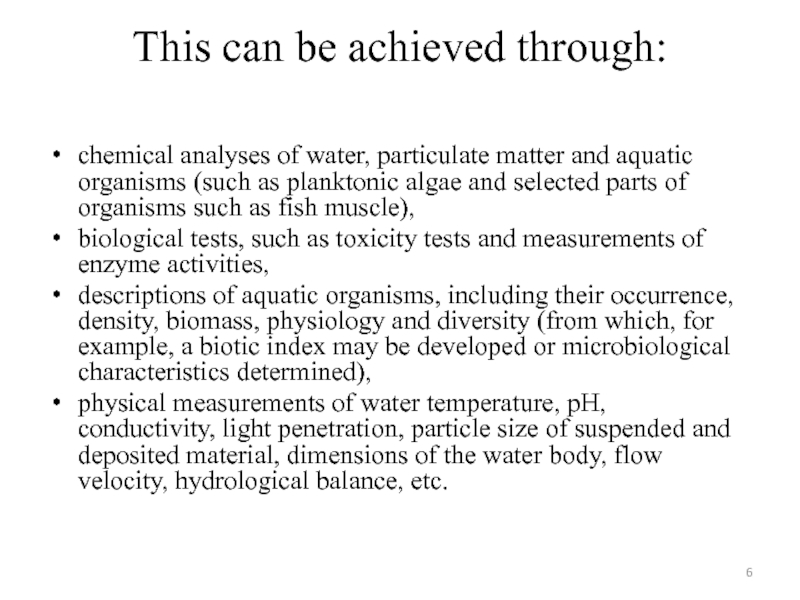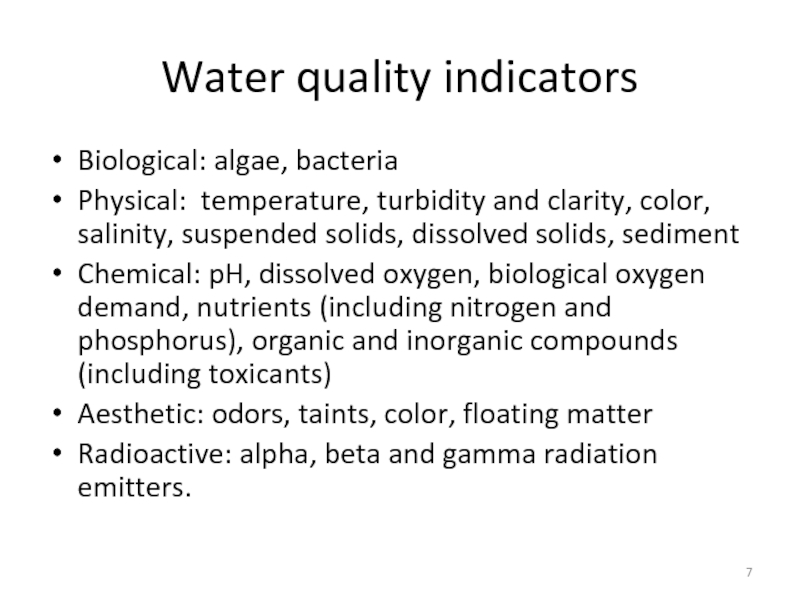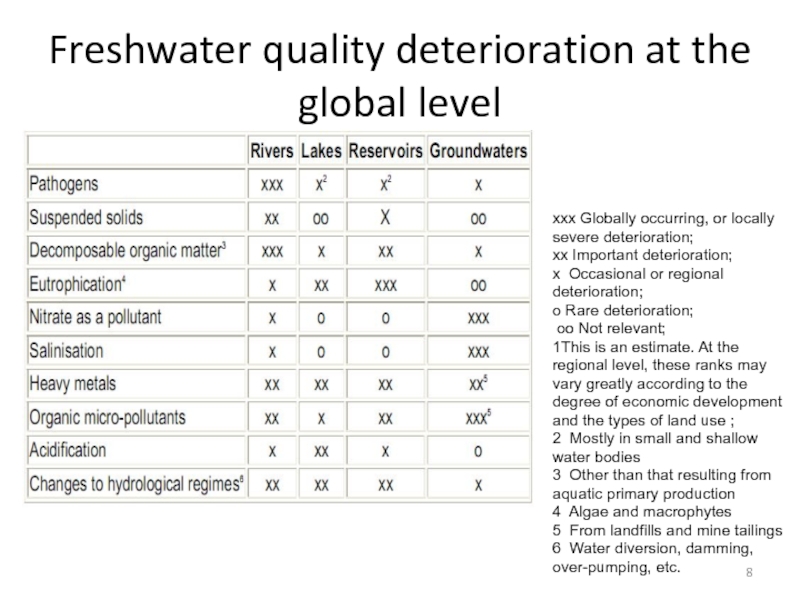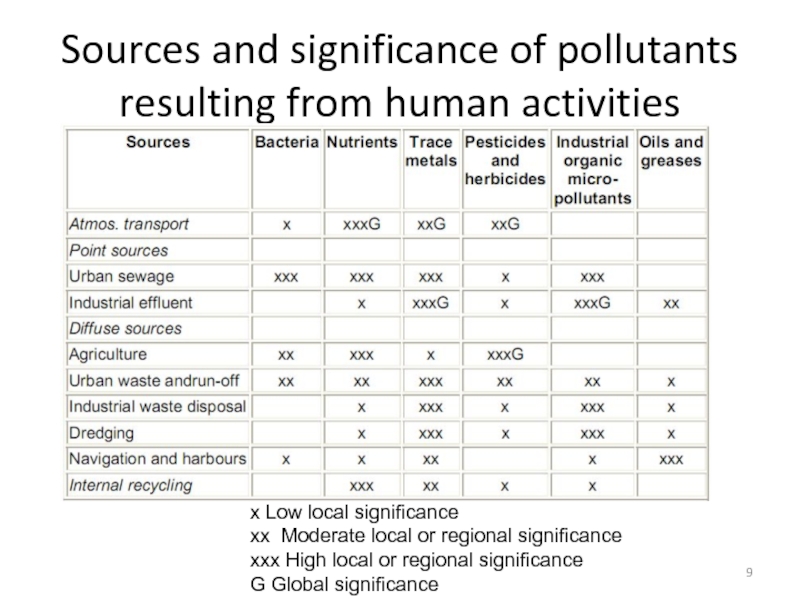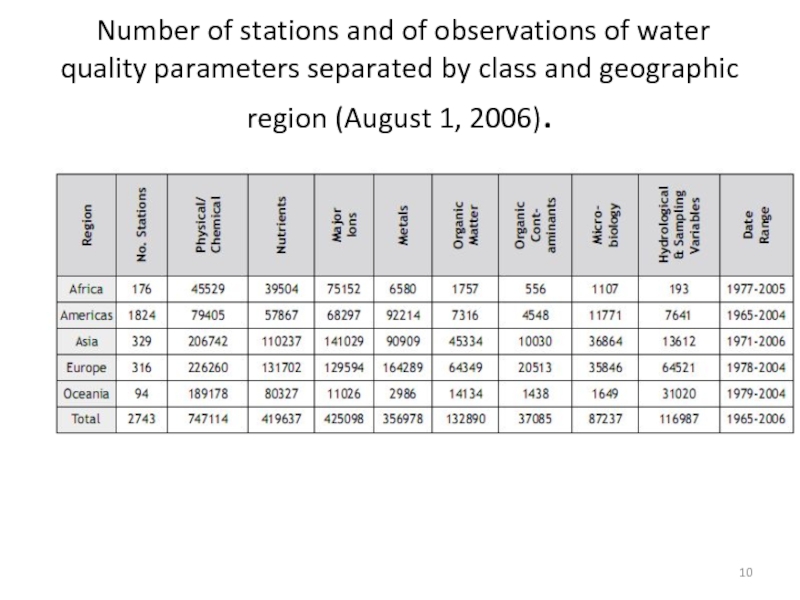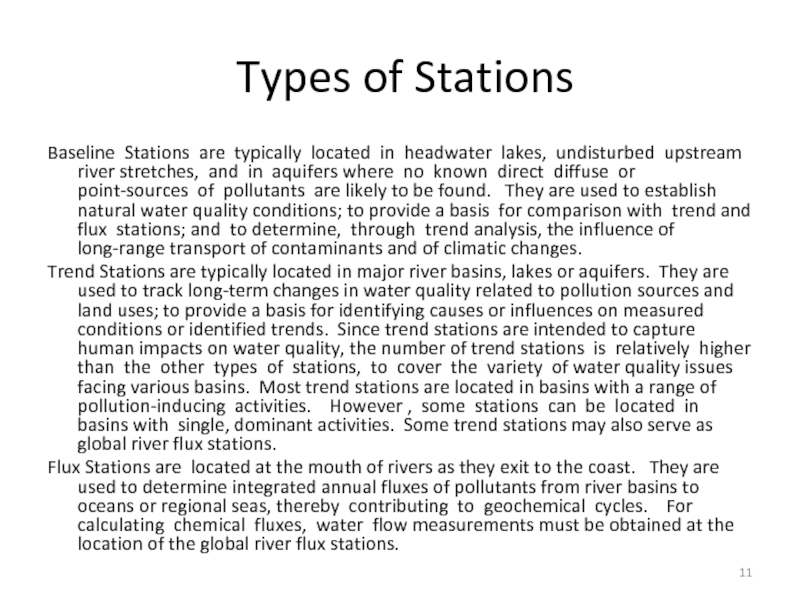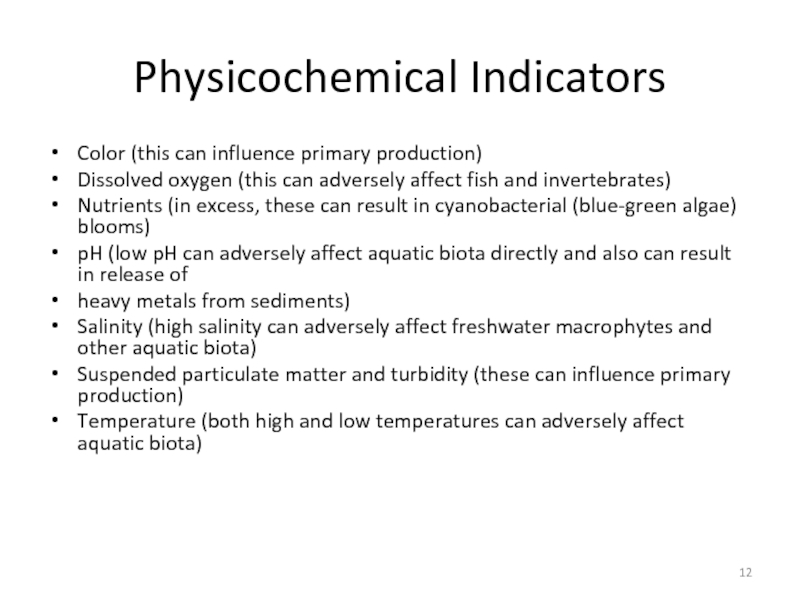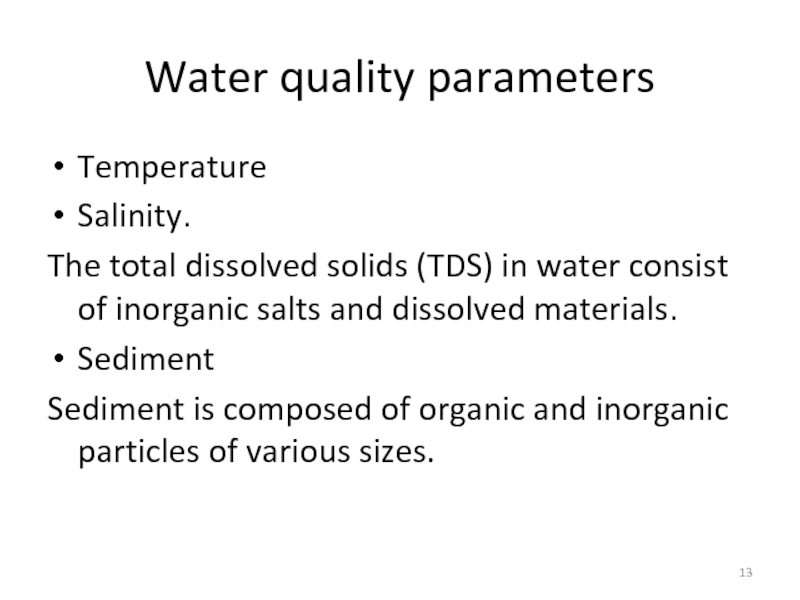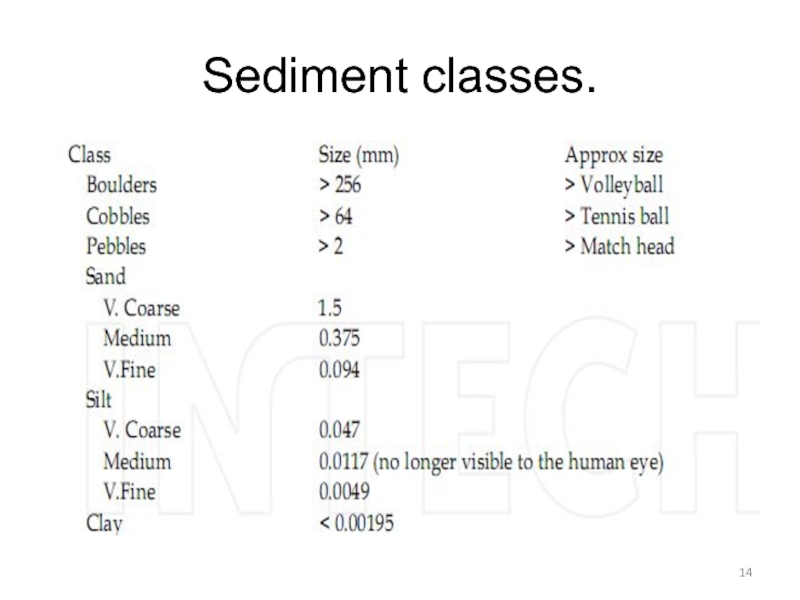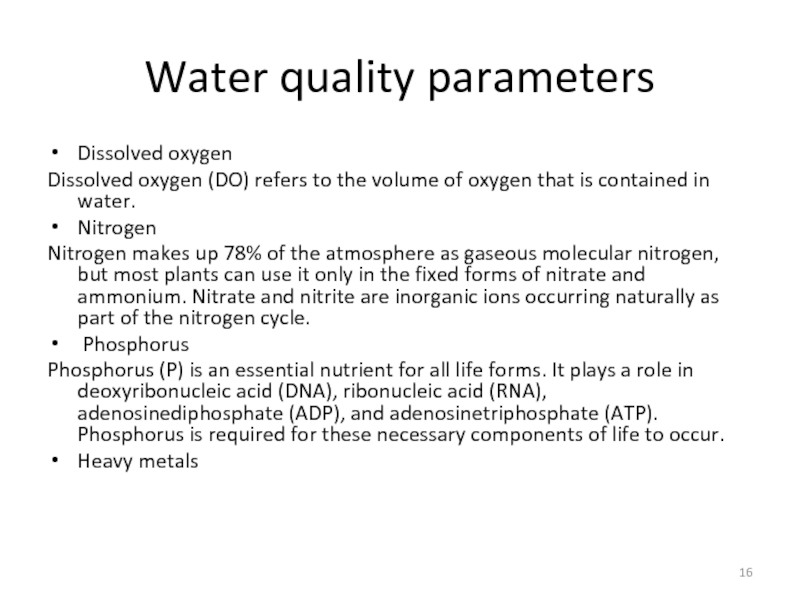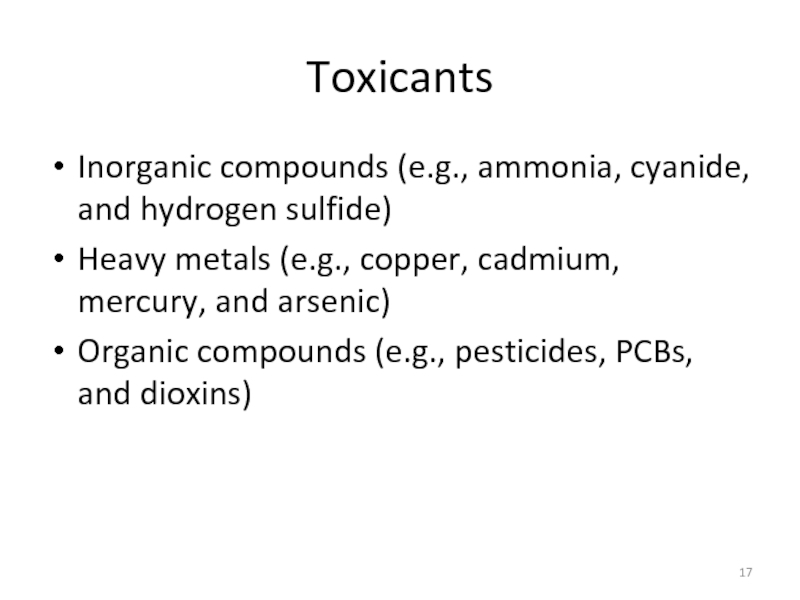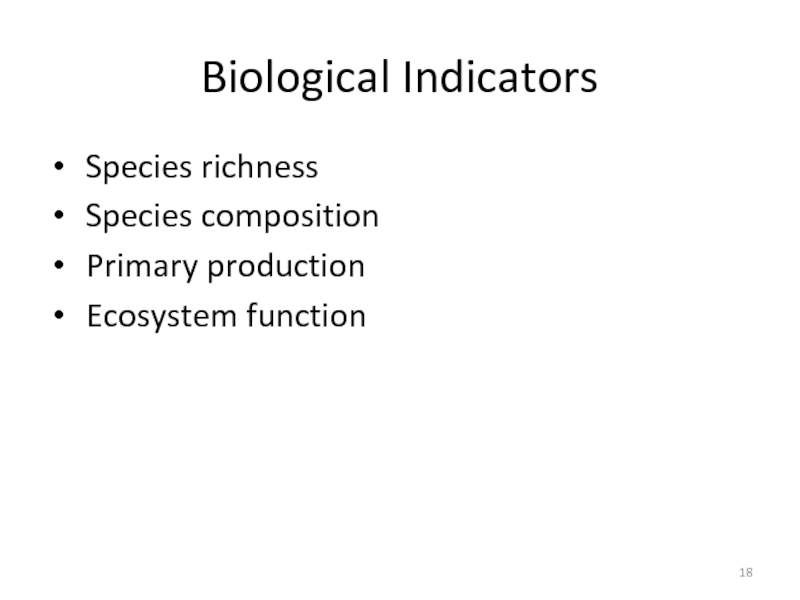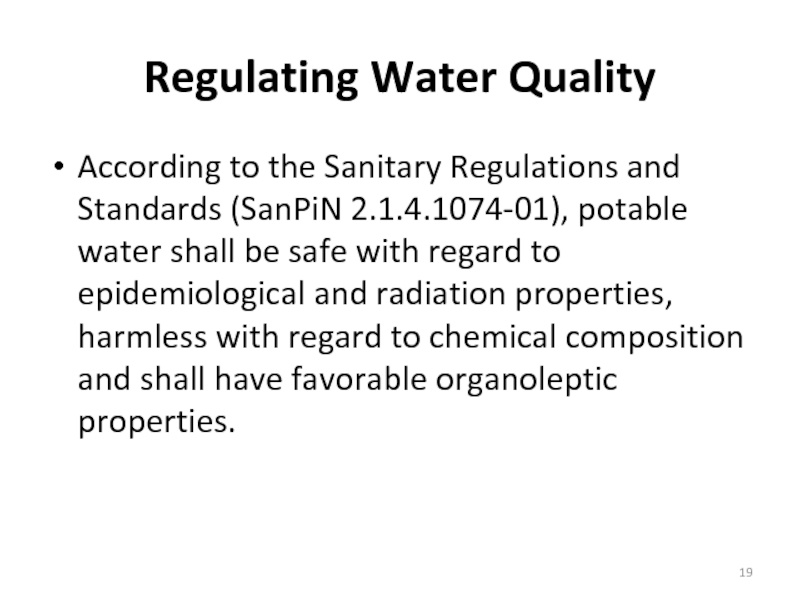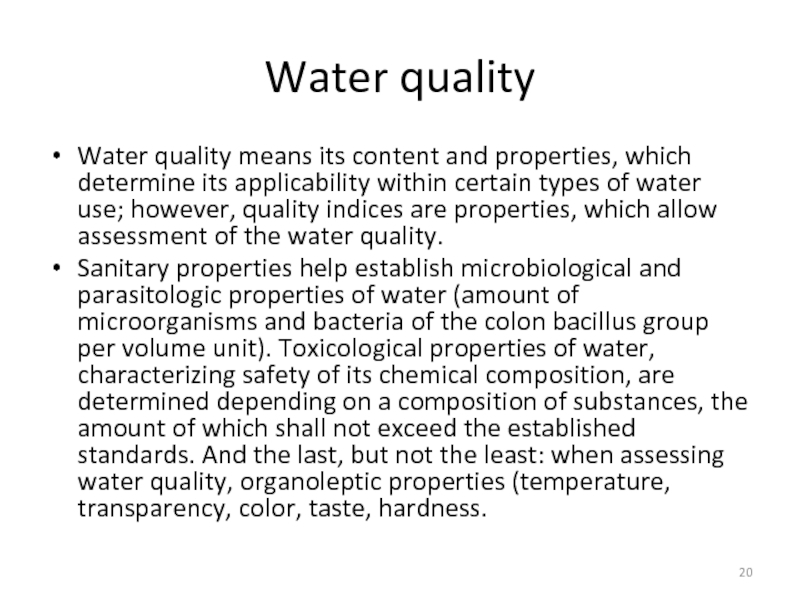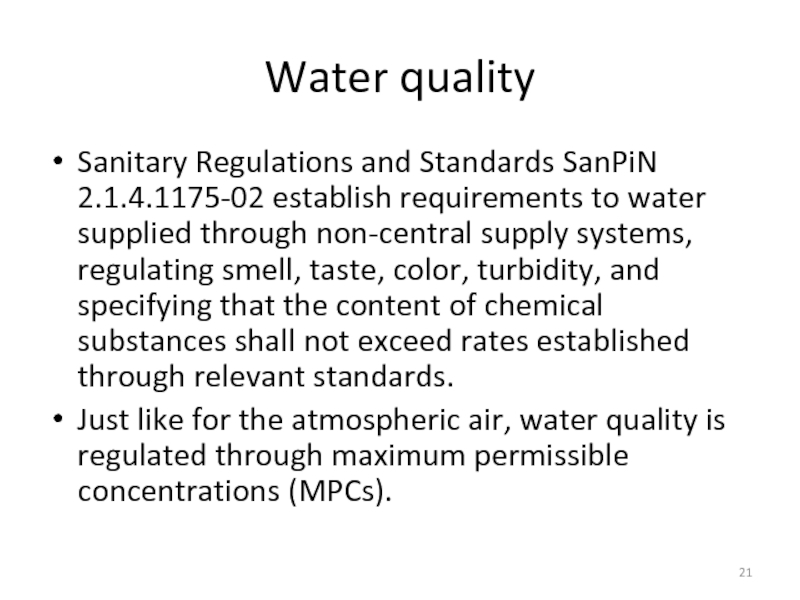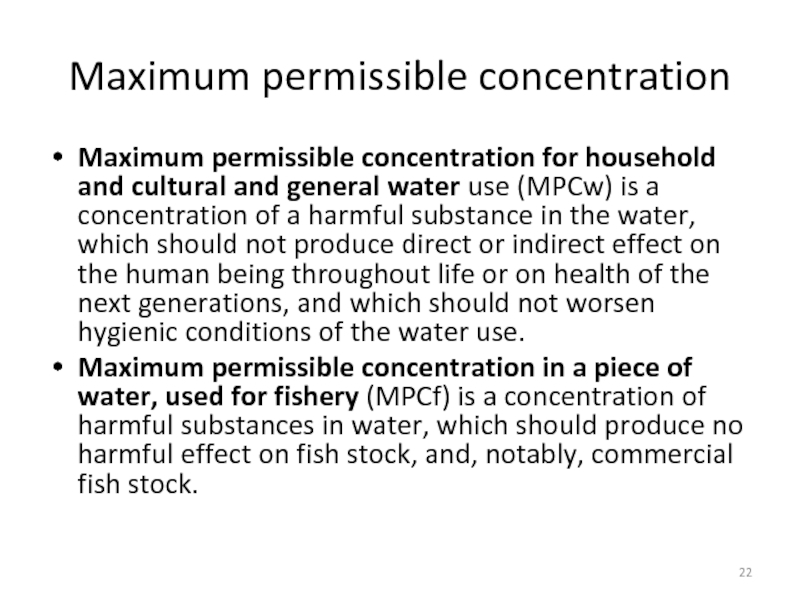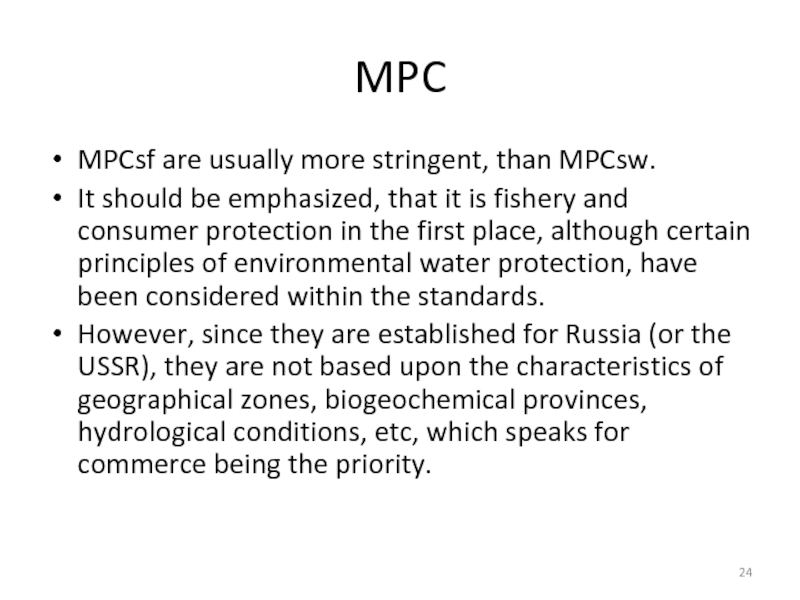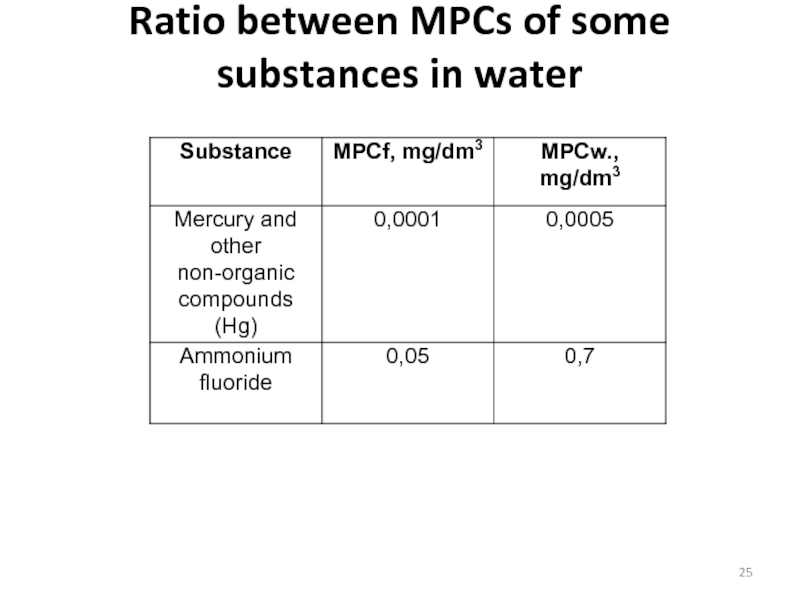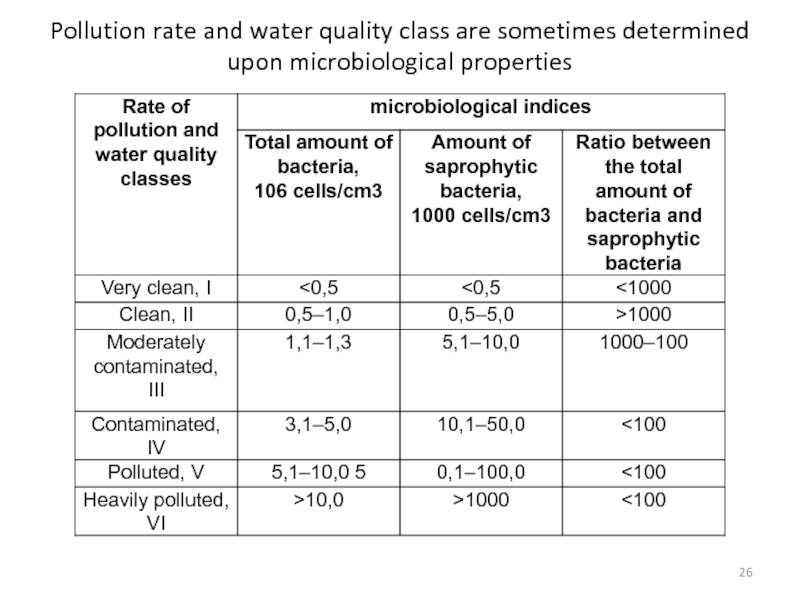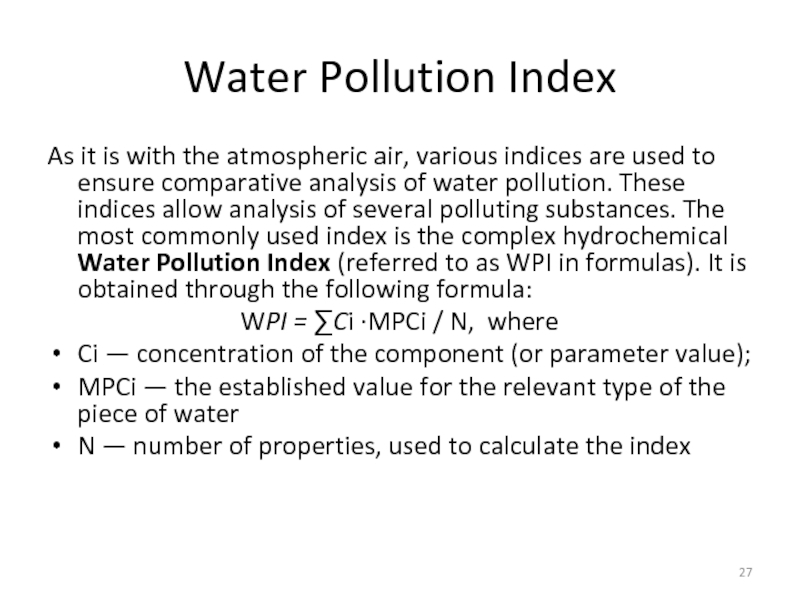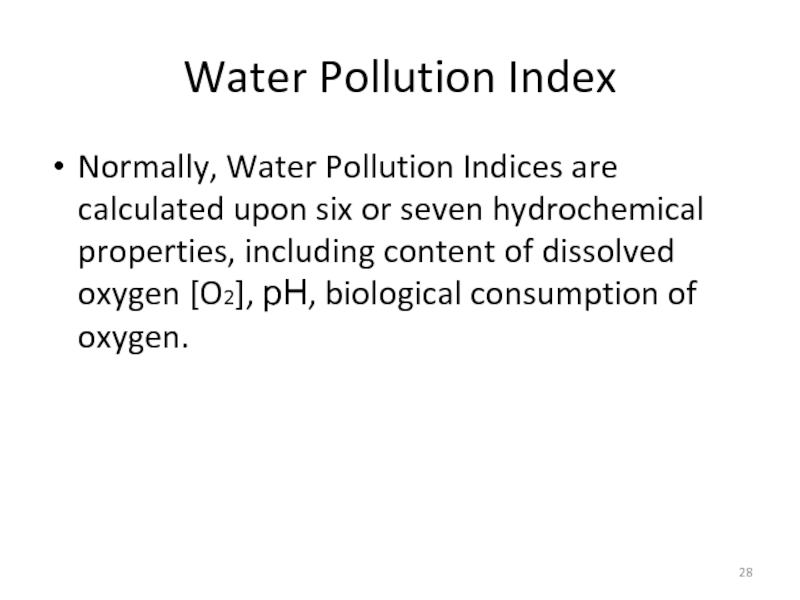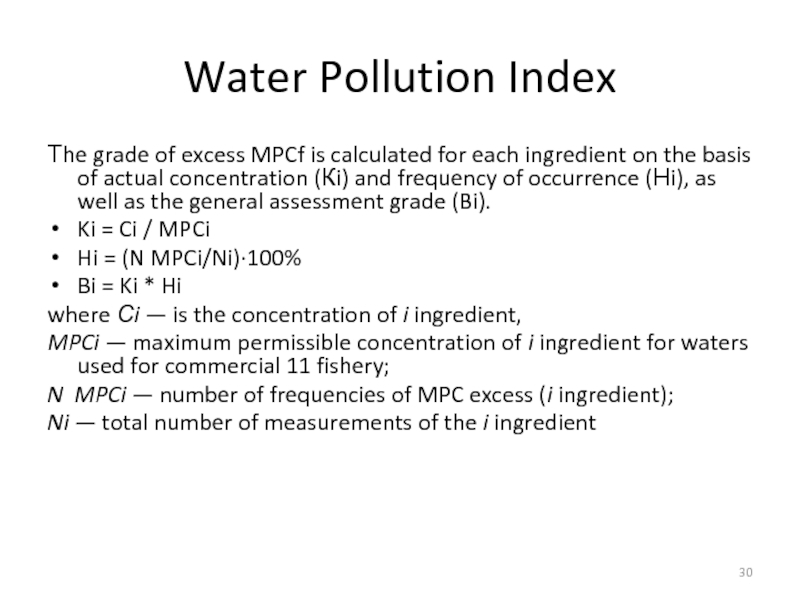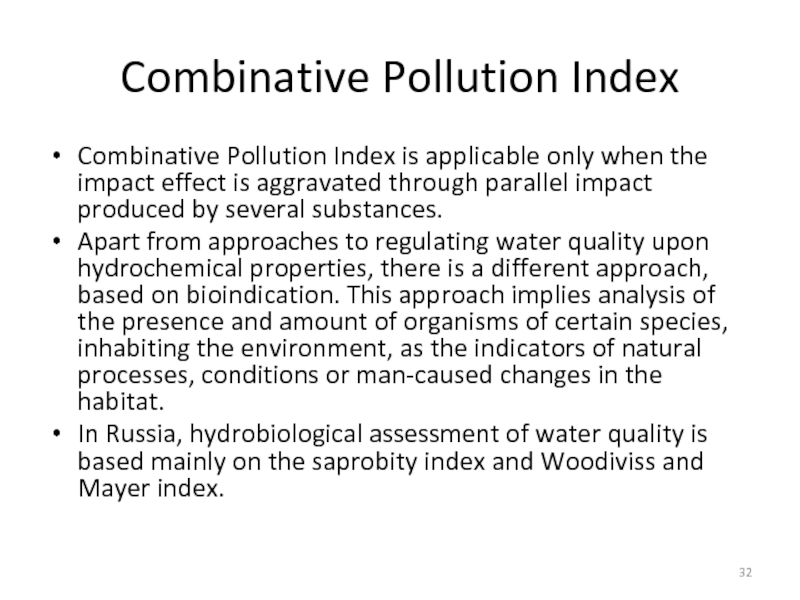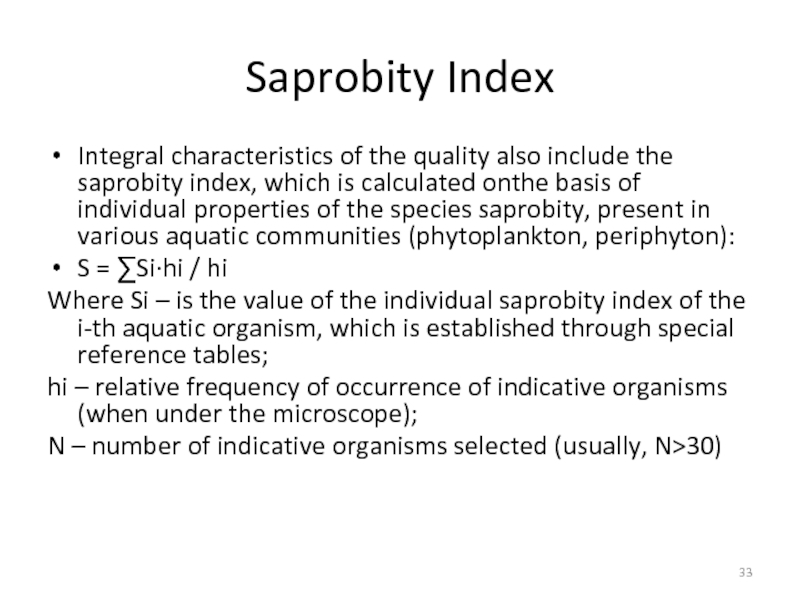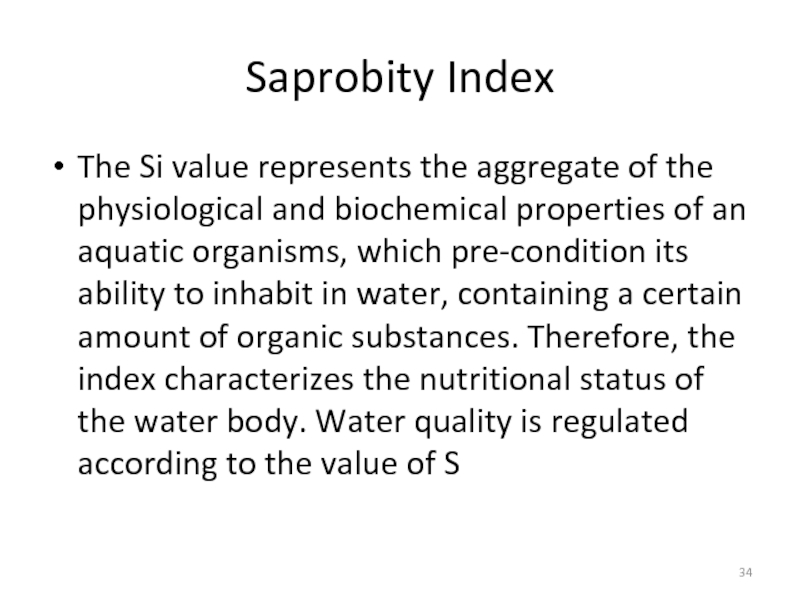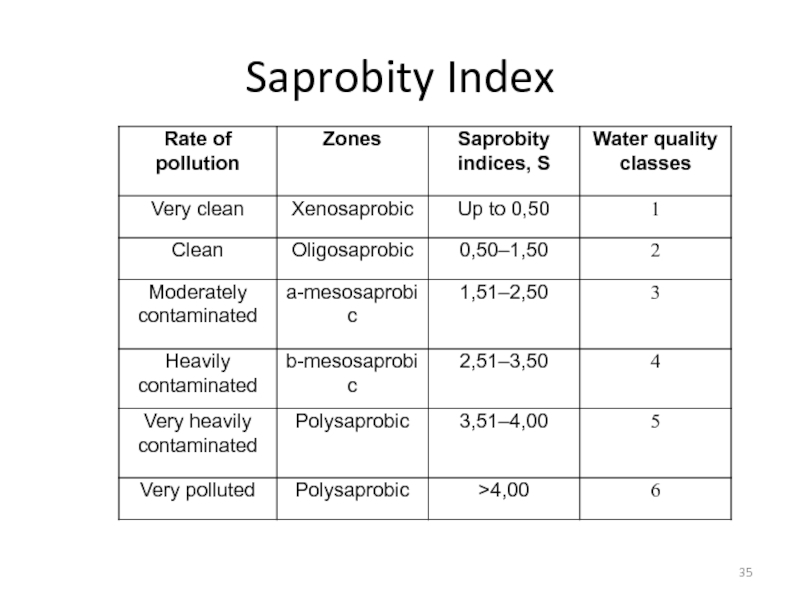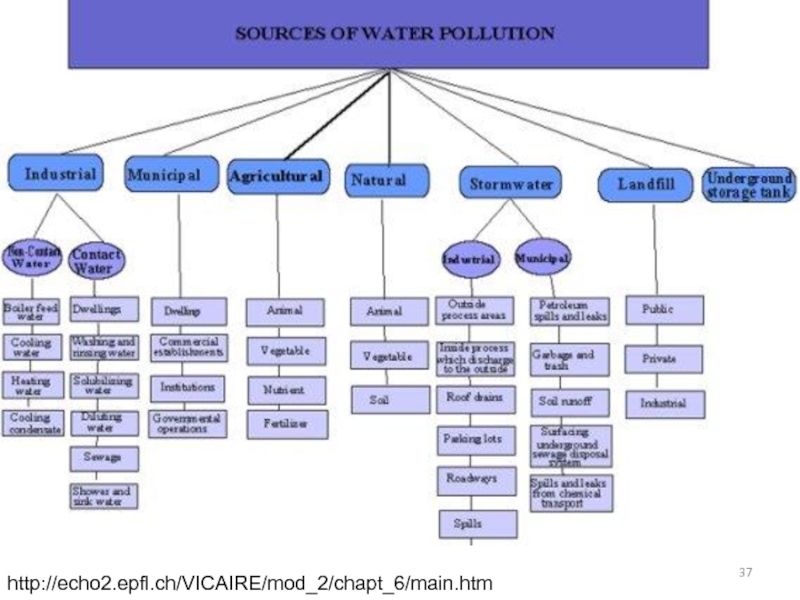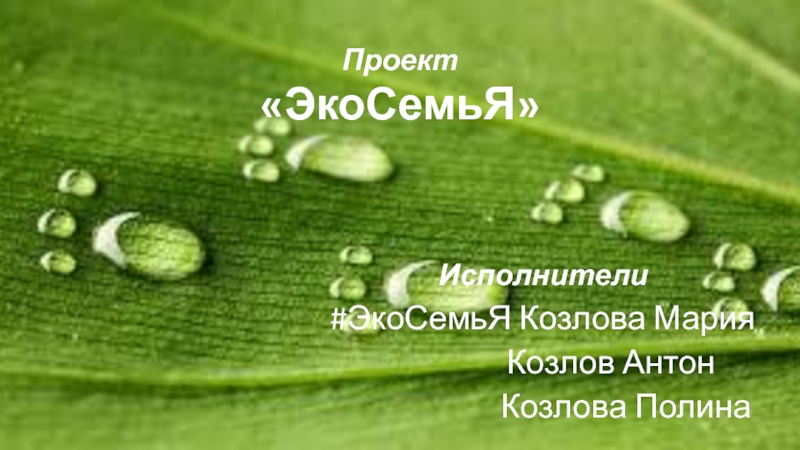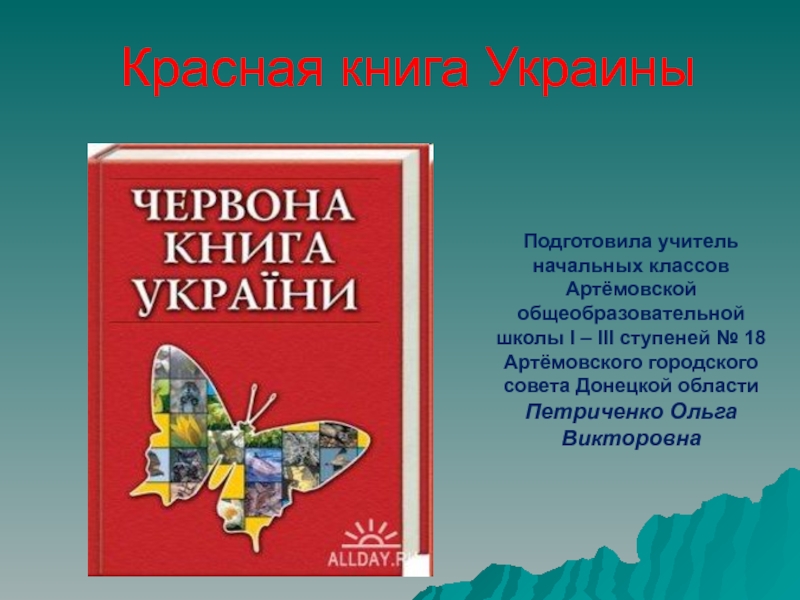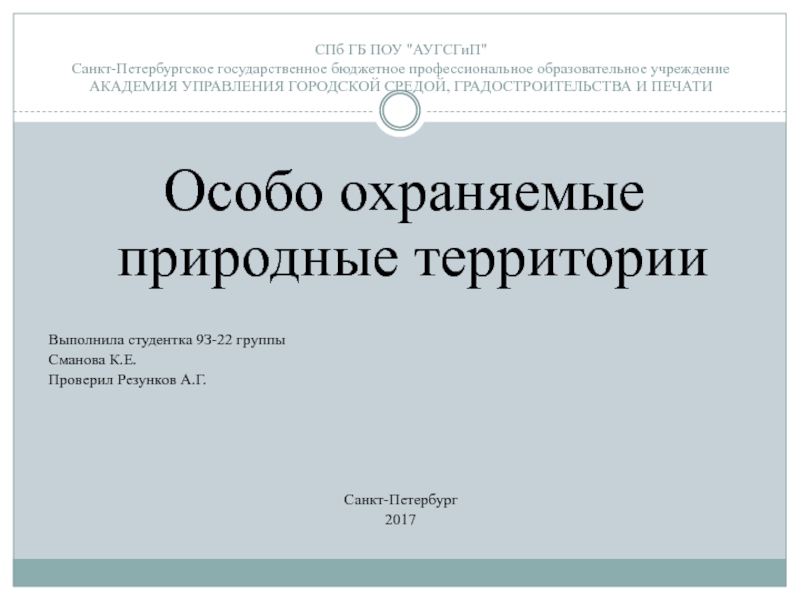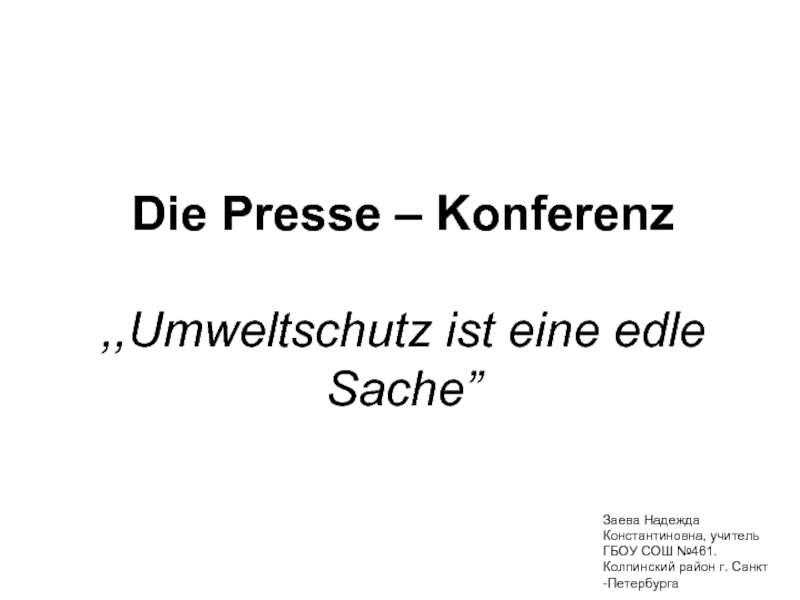- Главная
- Разное
- Дизайн
- Бизнес и предпринимательство
- Аналитика
- Образование
- Развлечения
- Красота и здоровье
- Финансы
- Государство
- Путешествия
- Спорт
- Недвижимость
- Армия
- Графика
- Культурология
- Еда и кулинария
- Лингвистика
- Английский язык
- Астрономия
- Алгебра
- Биология
- География
- Детские презентации
- Информатика
- История
- Литература
- Маркетинг
- Математика
- Медицина
- Менеджмент
- Музыка
- МХК
- Немецкий язык
- ОБЖ
- Обществознание
- Окружающий мир
- Педагогика
- Русский язык
- Технология
- Физика
- Философия
- Химия
- Шаблоны, картинки для презентаций
- Экология
- Экономика
- Юриспруденция
Regulating Water Quality презентация
Содержание
- 1. Regulating Water Quality
- 2. Water quality Water quality is commonly defined
- 3. Protecting aquatic ecosystems Aquatic ecosystems
- 4. The physicochemical indicators can be classified into
- 5. The quality of the aquatic environment is
- 6. This can be achieved through: chemical
- 7. Water quality indicators Biological: algae, bacteria
- 8. Freshwater quality deterioration at the global level
- 9. Sources and significance of pollutants resulting from
- 10. Number of stations and of observations
- 11. Types of Stations Baseline Stations are
- 12. Physicochemical Indicators Color (this can influence primary
- 13. Water quality parameters Temperature Salinity.
- 14. Sediment classes.
- 15. Water quality parameters pH pH is defined
- 16. Water quality parameters Dissolved oxygen Dissolved oxygen
- 17. Toxicants Inorganic compounds (e.g., ammonia, cyanide, and
- 18. Biological Indicators Species richness Species composition Primary production Ecosystem function
- 19. Regulating Water Quality According to the Sanitary
- 20. Water quality Water quality means its content
- 21. Water quality Sanitary Regulations and Standards SanPiN
- 22. Maximum permissible concentration Maximum permissible concentration for
- 23. MPC MPCf is often considered as an
- 24. MPC MPCsf are usually more stringent, than
- 25. Ratio between MPCs of some substances in water
- 26. Pollution rate and water quality class are sometimes determined upon microbiological properties
- 27. Water Pollution Index As it is with
- 28. Water Pollution Index Normally, Water Pollution Indices
- 29. Depending on Water Pollution Index, areas of water pieces are divided in classes
- 30. Water Pollution Index The grade of excess
- 31. Combinative Pollution Index Ingredients, for which the
- 32. Combinative Pollution Index Combinative Pollution Index
- 33. Saprobity Index Integral characteristics of the quality
- 34. Saprobity Index The Si value represents the
- 35. Saprobity Index
- 36. Integral Indices integral indices as such are
- 37. http://echo2.epfl.ch/VICAIRE/mod_2/chapt_6/main.htm
Слайд 2Water quality
Water quality is commonly defined by its physical, chemical, biological
Water may be used for drinking, irrigating crops and watering stock, industrial processes, production of fish, shellfish and crustaceans, wildlife habitats, protection of aquatic ecosystems, navigation and shipping, recreation (swimming, boating), and scientific study and education.
Слайд 3Protecting aquatic
ecosystems
Aquatic ecosystems are an integral part of our
Aquatic ecosystems play an important role in maintaining water quality and are a valuable indicator of water quality and the suitability of the water for other uses.
Aquatic ecosystems are valuable resources. Aquatic life is a major source of protein for humans. In most countries, like Portugal, commercial and sport fishing is economically important.
Слайд 4The physicochemical indicators can be classified into two groups:
● Those which
● Those which affect ecosystems indirectly (e.g., nutrients, turbidity, and excess organic matter)
Слайд 5The quality of the aquatic environment is a broader issue which
water quality,
the composition and state of the biological life present in the water body,
the nature of the particulate matter present,
the physical description of the water body (hydrology, dimensions, nature of lake bottom or river bed, etc.).
Слайд 6This can be achieved through:
chemical analyses of water, particulate matter and
biological tests, such as toxicity tests and measurements of enzyme activities,
descriptions of aquatic organisms, including their occurrence, density, biomass, physiology and diversity (from which, for example, a biotic index may be developed or microbiological characteristics determined),
physical measurements of water temperature, pH, conductivity, light penetration, particle size of suspended and deposited material, dimensions of the water body, flow velocity, hydrological balance, etc.
Слайд 7Water quality indicators
Biological: algae, bacteria
Physical: temperature, turbidity and clarity, color,
Chemical: pH, dissolved oxygen, biological oxygen demand, nutrients (including nitrogen and phosphorus), organic and inorganic compounds (including toxicants)
Aesthetic: odors, taints, color, floating matter
Radioactive: alpha, beta and gamma radiation emitters.
Слайд 8Freshwater quality deterioration at the global level
xxx Globally occurring, or locally
xx Important deterioration;
x Occasional or regional deterioration;
o Rare deterioration;
oo Not relevant;
1This is an estimate. At the regional level, these ranks may vary greatly according to the degree of economic development and the types of land use ;
2 Mostly in small and shallow water bodies
3 Other than that resulting from aquatic primary production
4 Algae and macrophytes
5 From landfills and mine tailings
6 Water diversion, damming, over-pumping, etc.
Слайд 9Sources and significance of pollutants resulting from human activities
x Low local
xx Moderate local or regional significance
xxx High local or regional significance
G Global significance
Слайд 10 Number of stations and of observations of water quality parameters
Слайд 11 Types of Stations
Baseline Stations are typically located in headwater lakes,
Trend Stations are typically located in major river basins, lakes or aquifers. They are used to track long-term changes in water quality related to pollution sources and land uses; to provide a basis for identifying causes or influences on measured conditions or identified trends. Since trend stations are intended to capture human impacts on water quality, the number of trend stations is relatively higher than the other types of stations, to cover the variety of water quality issues facing various basins. Most trend stations are located in basins with a range of pollution-inducing activities. However , some stations can be located in basins with single, dominant activities. Some trend stations may also serve as global river flux stations.
Flux Stations are located at the mouth of rivers as they exit to the coast. They are used to determine integrated annual fluxes of pollutants from river basins to oceans or regional seas, thereby contributing to geochemical cycles. For calculating chemical fluxes, water flow measurements must be obtained at the location of the global river flux stations.
Слайд 12Physicochemical Indicators
Color (this can influence primary production)
Dissolved oxygen (this can adversely
Nutrients (in excess, these can result in cyanobacterial (blue-green algae) blooms)
pH (low pH can adversely affect aquatic biota directly and also can result in release of
heavy metals from sediments)
Salinity (high salinity can adversely affect freshwater macrophytes and other aquatic biota)
Suspended particulate matter and turbidity (these can influence primary production)
Temperature (both high and low temperatures can adversely affect aquatic biota)
Слайд 13Water quality parameters
Temperature
Salinity.
The total dissolved solids (TDS) in water
Sediment
Sediment is composed of organic and inorganic particles of various sizes.
Слайд 15Water quality parameters
pH
pH is defined as the negative log-base 10 of
Слайд 16Water quality parameters
Dissolved oxygen
Dissolved oxygen (DO) refers to the volume of
Nitrogen
Nitrogen makes up 78% of the atmosphere as gaseous molecular nitrogen, but most plants can use it only in the fixed forms of nitrate and ammonium. Nitrate and nitrite are inorganic ions occurring naturally as part of the nitrogen cycle.
Phosphorus
Phosphorus (P) is an essential nutrient for all life forms. It plays a role in deoxyribonucleic acid (DNA), ribonucleic acid (RNA), adenosinediphosphate (ADP), and adenosinetriphosphate (ATP). Phosphorus is required for these necessary components of life to occur.
Heavy metals
Слайд 17Toxicants
Inorganic compounds (e.g., ammonia, cyanide, and hydrogen sulfide)
Heavy metals (e.g., copper,
Organic compounds (e.g., pesticides, PCBs, and dioxins)
Слайд 18Biological Indicators
Species richness
Species composition
Primary production
Ecosystem function
Слайд 19Regulating Water Quality
According to the Sanitary Regulations and Standards (SanPiN 2.1.4.1074-01),
Слайд 20Water quality
Water quality means its content and properties, which determine its
Sanitary properties help establish microbiological and parasitologic properties of water (amount of microorganisms and bacteria of the colon bacillus group per volume unit). Toxicological properties of water, characterizing safety of its chemical composition, are determined depending on a composition of substances, the amount of which shall not exceed the established standards. And the last, but not the least: when assessing water quality, organoleptic properties (temperature, transparency, color, taste, hardness.
Слайд 21Water quality
Sanitary Regulations and Standards SanPiN 2.1.4.1175-02 establish requirements to water
Just like for the atmospheric air, water quality is regulated through maximum permissible concentrations (MPCs).
Слайд 22Maximum permissible concentration
Maximum permissible concentration for household and cultural and general
Maximum permissible concentration in a piece of water, used for fishery (MPCf) is a concentration of harmful substances in water, which should produce no harmful effect on fish stock, and, notably, commercial fish stock.
Слайд 23MPC
MPCf is often considered as an environmental standard, which is not
No fish or organisms, being the fodder base, die;
No species of fish, which earlier inhabited the waters, disappear; no fish or organisms, valuable as fodder, are replaced with species, inappropriate for food;
No damage to commercial properties of the fish is observed,
No changes, which may potentially result in death of fish, replacement of fodder or loss of commercial properties of the species, occur.
Слайд 24MPC
MPCsf are usually more stringent, than MPCsw.
It should be emphasized,
However, since they are established for Russia (or the USSR), they are not based upon the characteristics of geographical zones, biogeochemical provinces, hydrological conditions, etc, which speaks for commerce being the priority.
Слайд 26Pollution rate and water quality class are sometimes determined upon microbiological
Слайд 27Water Pollution Index
As it is with the atmospheric air, various indices
WPI = ∑Ci ∙MPCi / N, where
Ci — concentration of the component (or parameter value);
MPCi — the established value for the relevant type of the piece of water
N — number of properties, used to calculate the index
Слайд 28Water Pollution Index
Normally, Water Pollution Indices are calculated upon six or
Слайд 30Water Pollution Index
The grade of excess MPCf is calculated for each
Ki = Ci / MPCi
Hi = (N MPCi/Ni)∙100%
Bi = Ki * Hi
where Сi — is the concentration of i ingredient,
MPCi — maximum permissible concentration of i ingredient for waters used for commercial 11 fishery;
N MPCi — number of frequencies of MPC excess (i ingredient);
Ni — total number of measurements of the i ingredient
Слайд 31Combinative Pollution Index
Ingredients, for which the value of the general assessment
CPI = ∑Si
Слайд 32Combinative Pollution Index
Combinative Pollution Index is applicable only when the
Apart from approaches to regulating water quality upon hydrochemical properties, there is a different approach, based on bioindication. This approach implies analysis of the presence and amount of organisms of certain species, inhabiting the environment, as the indicators of natural processes, conditions or man-caused changes in the habitat.
In Russia, hydrobiological assessment of water quality is based mainly on the saprobity index and Woodiviss and Mayer index.
Слайд 33Saprobity Index
Integral characteristics of the quality also include the saprobity index,
S = ∑Si∙hi / hi
Where Si – is the value of the individual saprobity index of the i-th aquatic organism, which is established through special reference tables;
hi – relative frequency of occurrence of indicative organisms (when under the microscope);
N – number of indicative organisms selected (usually, N>30)
Слайд 34Saprobity Index
The Si value represents the aggregate of the physiological and
Слайд 36Integral Indices
integral indices as such are not the assessment of the
High values of water pollution indices can also be preconditioned by natural properties of the catchment area (for instance, by ashen-gray soils, peats, which condition high content of organic substances in water, identified as oil products through some techniques, high natural content of cuprum, ore, manganese, low value of dissolved oxygen concentration, etc).
In this case, even rivers, experiencing minor mancaused loads, will be referred to as exceedingly polluted or polluted on the basis of water pollution indices.
Thus, state reports cover the case of the Pra river, which basin lies within the protected areas of Meschyora and Meschyorskiy national parks. Man-caused load isminor, certain sections of the river are included in the list of wetlands of international significance as home for rare water fauna species.
Therefore, one shall be careful assessing environmental load on the basis values, grounded upon the MPC system. These values are expedient for assessment of tendencies towards time changes or for comparison of various sections of the water body.

